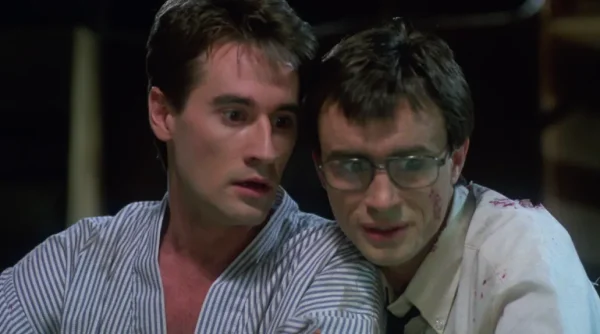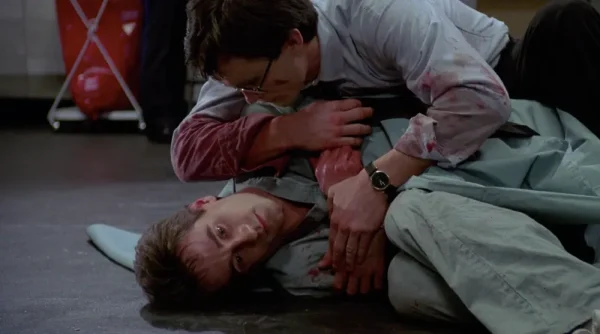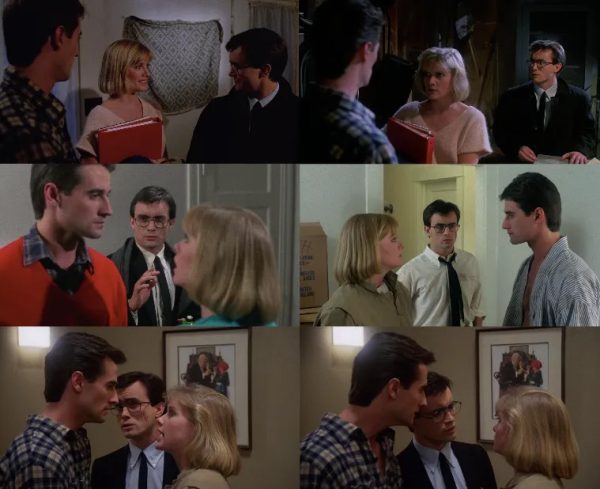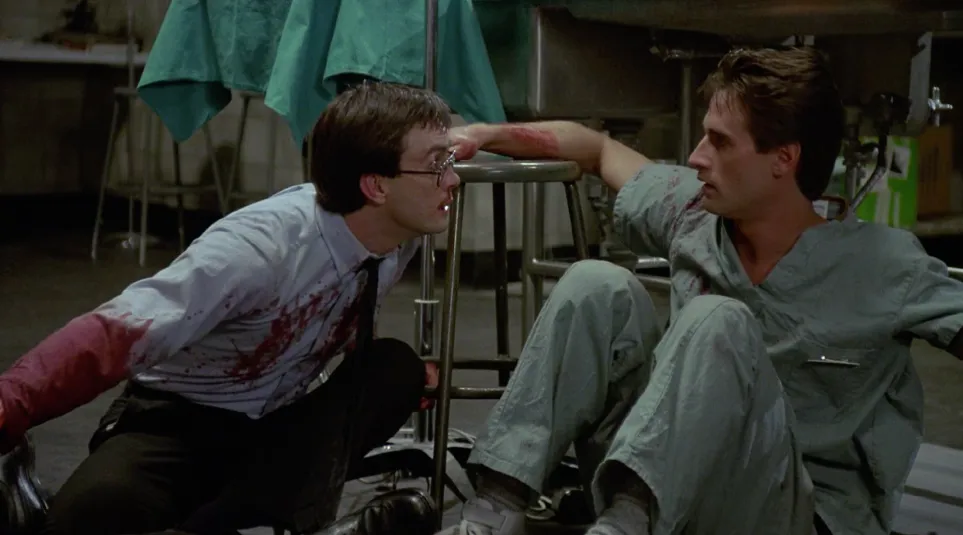Do you know what’s better than horror movies? Vintage horror movies.
In 1921 or 1922 (even Google’s not sure), H.P. Lovecraft released his horror short story “Herbert West—Reanimator,” containing the bomb of a piece “Six Shots by Moonlight”. And I say “bomb” in the bad way because it is like, super racist. I’ll–uhm—talk more about it soon.
In 1985, the story would be adapted into a movie, The Reanimator, directed by Stuart Gordon. The movie was entertaining, original, and, overall, a very enjoyable experience. It is, in short, everything you can expect from a horror movie. We got the scares, the creepy plot, the heavy mood, the gore—lots and lots of gore— two main male protagonists with a suspicious amount of sexual tension….wait, what?
Before we get into that, let’s talk a little about the original piece.
“Six Shots by Moonlight” appears dark and mysterious. Herbert West, an ambitious doctor obsessed with the idea of resuscitating the dead, sets up a secret laboratory near a graveyard and a factory with high rates of accidents. That is a very convenient location since their experiments require fresh corpses.
Dr. West has invested in this serum, which he injects in a corpse’s arm, and can bring it back to life. The narrator is not West, but instead his unnamed assistant, who functions in the fiction somewhat like Watson does in Sherlock Holmes. He gives us a clear view of Herbert West in his view, a cold scientist seeking to conquer death, regardless of the consequences.
The piece would be good if it wasn’t racist.
Lovecraft describes the character Buck Robinson, a Boxer that was beat to death in a fight, like this: “The negro had been knocked out, and a moment’s examination showed us that he would permanently remain so. He was a loathsome, gorilla-like thing, with abnormally long arms which I could not help calling fore legs, and a face that conjured up thoughts of unspeakable Congo secrets and tom-tom poundings under an eerie moon.” (Lovecraft, 1922).
That description not only slaps us in the face with an outrageous stereotype about Black people but also straight up strips Buck of his humanity. As if once was not enough, Lovecraft repeats that horrible portrayal at every chance he gets, from the claim that Herbert’s serum failed because it had only been tested on “white specimens,”—which implies that Black people and white people are somehow separate species—to the climax of the story, when Buck appears reanimated on the door with a child’s bone on his mouth.
I don’t know about you all, but it seems to me that Lovecraft simply wanted an excuse to portray a Black man as animalistic as he could, sending the message: ‘Black people eat little kids.’ Unfortunately, he saw in “Herbert West–Reanimator” a perfect chance to do it.
Thankfully, for the film, they came up with something nearly completely new.
The story starts in a school of medicine in Switzerland, where Dr. West, played by Jeffrey Combs, is discovered by the police attempting to resurrect his deceased mentor, Dr. Gruber. The consequence is that Herbert is transferred to the Miskatonic Medical School in Massachusetts. From then on, we get introduced to various completely new characters, including Daniel Cain (played by Bruce Abbott), a student in that medical school.
Daniel is engaged to Megan Halsey (played by Barbara Crampton), the daughter of the Dean of the college, Alan Halsey (played by Robert Sampson). Dan is introduced to Herbert by Halsey in the morgue, along with professor Dr. Carl Hill (played by David Gale), who has this theory that the brain completely dies 6-12 minutes after death, and that cannot be reverted. Herbert hates that theory deeply (Yeah, I wonder why!) and believes that the best way to express it is by breaking pencils in class every time the professor mentions anything related to it. It’s kind of hard to watch, to be honest.
That causes him and Dr. Hill to have a very grudgy relationship. From there, we are sent into a situation involving Daniel, Megan Halsey, Alan Halsey, Dr. Hill, and Herbert. Basically, what happens (without spoiling it so much, I hope) is that Herbert and Daniel end up being roommates. (AND THEY WERE ROOMMATES!!!)
Since Dr. Hill hates Herbert for breaking pencils during his class, he convinces Alan Halsey that Daniel is bad news for his daughter because he is rooming with Herbert. Well, excuse you, Dr. Hill, if in college, the options for normal people to room with are quite limited. #JusticeforPeopleWithWeirdRoommates.
The characters changed a lot from the fiction. The film has many more, instead of focusing on just Herbert and his assistant, which I think is a good expansion of the original piece. I did, however, have mixed feelings of love and hatred about this expansion.
What I loved was Herbert. In the fiction, we grasp how reserved he is, since not many social people agree to live in an isolated tall-grass right next to a graveyard. We see that he is passionate about his work and can do quite bold things because of it. I have this fixed idea that if by the end of the movie I am not able to name at least five character traits of a character, then the character had no personality. In Herbert, I counted more than ten: introverted, passionate, bold, intelligent, arrogant, ruthless, amoral, oddly charismatic, narcissistic. Very insensible. It also helps that Jeffrey Combs delivers an incredible performance on Herbert’s character.
I hated Megan Halsey’s character. We get nothing of what her major is, what she does, what she likes, if she has any hobbies; nothing. The filmmakers must have seen her as the perfect opportunity to latch on to the public’s sympathy by portraying the picture of the damsel in distress. Her presence in the narrative changes nearly nothing in the plot. It seems as if the writers used her to be something that needed to be saved and would attract Daniel and Herbert to where they needed to be—the school’s underground crazy lab.
I would have excluded Megan completely from the story, or at least tried to give her a role bigger than screaming all the time and having Daniel constantly—constantly—save her. I am aware that I am placing an unjust amount of pressure in a movie from the 80s on matching my modern feminist ideals, but I just cannot shake off the idea that the plot would have worked just fine without Megan’s presence.
Here’s a BIG SPOILER ALERT!!!
The scene by the end of the movie, which features Megan tied naked to a hospital bed while the dead, headless corpse of Dr. Carl Hill sexually assaults her, is a disgrace. Monstrous, and not in a thrilling-horror-movie kind of way. Monstrous in an unnecessary-sexist-display-of-violence-that-was-only-there-to-fulfill-the-perverted-desire-of-the-male-writers-and-the-male-audience kind of way.
Spoiler’s over folks, you may keep reading.
The writers seem to use Megan as an instrument to make the audience understand that they are supposed to hate Dr. Carl Hill. They did that by making Hill have a weird, repulsive obsession with Megan throughout the whole movie. It’s true that Hill does other evil things (many others, actually), but I feel like these deeds take the back seat to the fact that he is a sexual assaulter. Please, guys, men don’t have to be sexual assaulters to be villains! There are other ways to make the audience hate a character! I beg you, stop making women’s suffering a handle to pull on the audience’s hatred! We’ve had enough.
The dilemma between Dan, Megan, Herbert, Dr. Hill, and Alan Halsey was not really well executed. That is because Daniel is not given any justification for still siding with Herbert in the first place. Dan does not seem to have a particular passion for Herbert’s project. The rational action anyone would make at this point is to side with your girlfriend, who clearly hates your roommate, and stop getting involved in weird, undead, crazy stuff. That is not what we get, though. Even though Daniel barely knows Herbert, he constantly agrees to risk his place in the university, or even his life for him.
There is no logical explanation for that, except, of course, that he loved Herbert. (And not in a “roommates” kind of way!)
What, you’re not convinced? Allow me to make up your mind.
First, it is important to acknowledge that Herbert’s queer coding is not really portrayed in a positive way. I think we’ve already seen quite enough samples of Lovecraft’s open racism, but he was also homophobic, calling homosexuality a “perversion” and “repugnant to the overwhelming bulk of mankind.” With that in mind, we can conclude that Lovecraft’s queer coding is far from a representation of the gay community, but rather Lovecraft’s attempt to make Herbert’s character more “disturbing” according to his own homophobic and misogynist views.
With that in mind, let’s go into why can Herbert and Daniel’s relationship can be seen as queer coding, both in the novel and in the 1985 film.

“Birth is always painful”, Re-Animator, 1985.
First off, we have the very idea of the plot: two men can create life without the help of a woman. In the short story, the Narrator (who may or may not be Dan Cain, as he is unnamed) describes himself as being Herbert’s “inseparable assistant” and his “closest companion”. The duo is also apart from everyone else, living and working together in an isolated house. If that is not a euphemism for being closeted, then I don’t know what is anymore. The fact that the Narrator mentions that Herbert is particularly interested in males with “especially vigorous physiques” only adds to that.
In the movie, we see Dan engaged to a woman, yet instead of confirming Daniel’s heterosexuality, that paints Herbert as someone who challenges it. That is because, as I previously mentioned, Dan is constantly expected to choose between Megan and Herbert. In the vast majority of the times, he picks Herbert.
There is a clear rivalry between Megan and Daniel. From the moment Herbert walks into Dan’s apartment, Megan is uncomfortable, and I’d even go as far as stating that her look says, “Who is this other woman?” On the other hand, Herbert often appears irritated with Megan, sighing and saying “Damn the bitch” when she interrupts his and Dan’s experiments. That irritation comes from no particular reason, except, perhaps, jealousy.
There are also the smaller incidents, like the multiple times Herbert hovers in Dan’s personal space, clutching him, getting behind him, and even embracing him. Dan is the only person in the movie to whom Herbert isn’t indifferent and actually shows tenderness. We see this in scenes where he covers Dan with a blanket after the latter falls into a state of shock.

“It’s shock. Don’t worry.” The Reanimator, 1985.
Even the way Herbert calls Dan—an elongated ‘Dan,’ like ‘Daaaaan’—mirrors the way Megan calls him. Herbert also uses the nickname ‘Danny’ for Daniel, which, aside from him, is only used by Megan.

“I can’t believe that it’s finally me and you, and you and me, just us, and your friend HERBERT! Do-do-do-do-do-do HERBERT!”
Lastly, if this helps to convince you, Herbert is low-key a twink. This is how he is described in the fiction: “a small spectacled youth with delicate features, yellow hair, pale blue eyes and a soft voice.” Even in the film, Herbert is smaller than Dan and often relies on him for protection.
This is the end, folks…
I hope I could convince you—at least a little bit—of the apparent queer codeness present both in Lovecraft’s fiction and the 1985 film. Of course, I highly encourage you to watch it—or read it—and come to your own conclusions.
References
Harrison, Stephanie. Herbert West—Reanimator: Six Shots by Moonlight. H. P. Lovecraft, 204-208.
Gordon, Stuart, dir. The Reanimator. Empire Pictures, 1985.
Gorezone, The. “Comrades in Science: The Homoerotic History of Re-Animator (Part I).” Medium, 19 Mar. 2025, medium.com/@thegorezone/comrades-in-science-the-homoerotic-history-of-re-animator-part-i-f8bf3f2785e8.








